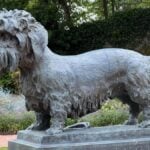
Home » What is a Dinmont Dandie Terrier?

To understand this breed, step back to Selkirk, Scotland, in November 1875, when the Dandie Dinmont Terrier Club (UK) held its first meeting, followed by the adoption of the first Breed Standard in 1876. The year 2025 is the 150th anniversary of the founding of the club, which to this day represents the Dandie Dinmont Terrier in its land of origin. The first Dandie Dinmont of record is known as “Old Ginger,” whose statue is located outside the restored original kennels at The Haining.

The first Dandie imported to the US arrived in 1886! The current parent club in America is the Dandie Dinmont Terrier Club of America (DDTCA), founded in 1932, and as the successor to an earlier AKC (American Kennel Club) member club for Dandie Dinmont Terriers, gives our breed over 100 years of club membership with AKC.
The legendary character of the Dandie Dinmont was described by Sir Walter Scott in his book Guy Mannering in which he speaks of “auld Pepper” and “auld Mustard,” and “young Pepper” and “young Mustard,” and “little Pepper” and “little Mustard,” and their gameness with rats, weasels, foxes, and badgers. This connection to Sir Walter lives on, thanks in part to the 10th Duke of Buccleuch, Chief of Clan Scott, giving the Dandie Dinmont Terrier permission to adopt the Walter Scott Tartan as the official tartan of the breed.

In her book, Dandie Dinmont Terrier, well-known breeder-judge Betty-Anne Stenmark gives the following extremely accurate description of living with a Dandie Dinmont:
“The Dandie is the gentleman of the terrier group, more placid and quiet than most of his terrier cousins. He is relatively calm and sensible, quite placid unless his ‘terrier’ is aroused. At that point he becomes all-terrier and will pursue whatever interests him
with tenacity.
“The Dandie is a companion dog par excellence; to his fans he has no equal. He thrives on being with those he loves and doesn’t take kindly to being locked away; he is a miserable kennel dog.”

There is no other terrier like the Dandie. His head is strongly made featuring large round eyes, a moderately large nose and a strong, deep muzzle all topped by a glorious cream or silver topknot of hair.
Low stationed, the Dandie is 8 to 11 inches tall at the top of the shoulders, and from the top of the shoulders to the root of the tail is 1 to 2 inches less than twice the height. Clearly, the Dandie is one of the longest terriers. Equally unique to the breed is the topline and the corresponding underline.
Topline is rather low at the shoulder, having a slight downward curve with a corresponding arch over the loin, followed by a very slight drop to the root of the tail. In other words, a level topline is incorrect for a Dandie! The underline reflects the curves of the topline. When in doubt evaluate the outline of the Dandie on the move where the long, low, weasley characteristics of the correct outline become obvious.

When seeking to acquire a Dandie, patience is a virtue. The Dandie Dinmont is a vulnerable breed in the United States as well as in the United Kingdon, its homeland. Concerns over the future of the Dandie were expressed as far back as 1975 when Mustard and Pepper, the DDTCA’s quarterly magazine, published an article by Phyllis Salsberry, known worldwide for her Salismore Dandies in England. To quote the article: “The breed today needs more enthusiastic up and coming young breeders who are willing to apprise and, in some cases, even discard from their breeding program their own Dandies. Since the days of Tinker Allen, these dour little Scottish borders have given their loyalty and devotion to man so surely, we owe it to them to give as much in return.”

Going to the Dandies requires a significant commitment to the future of the breed. In the Conformation world, Dandies are known as one of the most difficult breeds to groom, as keeping the show Dandie in a true rolling penciled coat, with furnishings, requires, at a minimum, weekly attention to stripping and grooming, adjusting the furnishings as time goes by. Not every Dandie born is a Conformation-quality Dandie, and truly committed breeders recognize that not all puppies will become Champions. However, there is another world in which the Dandie is well prepared to participate and shine: Performance events!

How can you learn more about the breed and eventually bring a Dandie into your life and home? Visit the DDTCA’s website (https://www.ddtca.org) for more information, photographs, Dandie Dinmont swag, and contact information. Attend the National Specialty, held annually in late May/early June at Purina Farms in Gray Summit, Missouri. Contact the club’s Breeder Referral Specialist to identify breeders and potential puppies available in your area. Subscribe to the DDTCA’s quarterly newsletter, Mustard and Pepper, for up-to-date news and a complete contact list for all DDTCA committees. Once you have met members of the club, and perhaps even found your first Dandie Dinmont puppy, consider joining the DDTCA. Together, we will ensure the preservation of this wonderful terrier breed.
